We pedalled past the white seated Buddha statues, each a moment of stationary meditation glimpsed amongst the trees. We had hired the bikes the previous evening from one of the many hire shops lining the approach road to the ancient city of Sukhothai. Paolo, our guest house owner, recommended the place. Visitors on old single-gear sit-up-and-beg bicycles cruise the roads that run through and around the ruins. Sukhothai is a delightful place for a bicycle ride, whether or not you're greatly interested in archaeology. The roads are predominantly level, the Historical Park is mostly woodland with large ponds that reflect the towering chedis or Buddha statues. Thai drivers are, on the whole, slow and courteous, though they have a tendency unusual to Sukhothai for announcing their approach behind you with a blast on the horn. Well-intended I'm sure but annoying after a short while. The site is spread out over a large area so bicycles really are the way to go. They make visiting all the main temples in the Historical Park easy to do in a day. There are also numerous temples beyond the original city walls, which form a rectangle 2km across, that require some form of transport to reach. Mopeds and mini-vans are other options but if you have the energy and fitness, bicycles allow you to take in the surrounding landscape and say hello to many people in passing.
We visited the Historical Park over five days, catching it in early morning and late afternoon light. The core of the Park are the temples and ponds that formed the very centre of ancient Sukhothai. Here are the remains of at least eleven of the grandest temples, many still hosting graceful Buddha statues, separated by tranquil ponds. The best-preserved is Wat Mahathat, a sprawling range of brick walls, columns, chedis and platforms set in a garden of trees and lawns. Mahathat was the spiritual heart of the city and would have held important relics of the Buddha under its spire-like chedi. Today, a large Buddha statue serenely sits in mediation at the front of the ruined temple hall and is still an important pilgrimage site. There are always offerings of candles, incense and flowers laid in front of his feet and, if you're lucky, you may see orange-robed and chanting monks leading a ceremony.
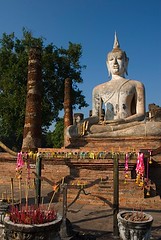
Two giant standing Buddhas flank either side of the chedi, their arms held out in supplication. Their robes are so finely made from limestone stucco that they seem to sway. Bridges and pathways radiate out from Matathat for you to explore the surrounding temples, each with its own character and distinctive Buddha image. One chedi is supported on a base of very patient elephants. There is enough to explore for at least a morning and if the heat becomes too much by mid-day there are plenty of fruit sellers under shady trees while the modern town with its cafes and restaurants is only a short distance away. It is worth hanging out in the Historical Park until sunset when you will find the Buddha images and temples are silhouetted against the rich oranges and blues of the sky. We had cloudless skies during our visit and while we missed out on the textured multi-hued skies that sun-lit clouds bring, even the gentle transition of a sky darkening from blue to black via bands of orange and red is a spectacle worth seeing.

Two giant standing Buddhas flank either side of the chedi, their arms held out in supplication. Their robes are so finely made from limestone stucco that they seem to sway. Bridges and pathways radiate out from Matathat for you to explore the surrounding temples, each with its own character and distinctive Buddha image. One chedi is supported on a base of very patient elephants. There is enough to explore for at least a morning and if the heat becomes too much by mid-day there are plenty of fruit sellers under shady trees while the modern town with its cafes and restaurants is only a short distance away. It is worth hanging out in the Historical Park until sunset when you will find the Buddha images and temples are silhouetted against the rich oranges and blues of the sky. We had cloudless skies during our visit and while we missed out on the textured multi-hued skies that sun-lit clouds bring, even the gentle transition of a sky darkening from blue to black via bands of orange and red is a spectacle worth seeing.
One morning as I wandered to the west of Matathat, before the sun had risen above the trees, I stood entranced as clouds of white mist drifted languidly above the ponds. The whole world was white, pierced only by the vibrant purple of floating lotus blossoms. As the sun broke over the tree tops, the towering chedi of a temple beyond the pond glowed orange against a backdrop of still-dark woodland. The orange light seemed to slide down the chedi to engulf it and a white-stuccoed Buddha image until he shone bright amongst the pale land.
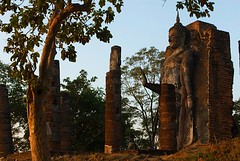
Sunrise is a magical time of day elsewhere in Sukhothai. The following morning I cycled, shivering in the pre-dawn cold, to Wat Saphan Hin set on a hilltop to the west of the city. The sun rises directly above the city and over a flat plain extending from the bottom of the hill to beyond the horizon. The morning I was there the sun rose as a solid orange globe in a cloudless sky. Here, the statue is of Buddha standing with his right arm extended and his hand facing out to greet the new day across the ancient city.

Sunrise is a magical time of day elsewhere in Sukhothai. The following morning I cycled, shivering in the pre-dawn cold, to Wat Saphan Hin set on a hilltop to the west of the city. The sun rises directly above the city and over a flat plain extending from the bottom of the hill to beyond the horizon. The morning I was there the sun rose as a solid orange globe in a cloudless sky. Here, the statue is of Buddha standing with his right arm extended and his hand facing out to greet the new day across the ancient city.
I was only able to cycle out so early and to see so much because I chose to stay in Old Sukhothai. There are, confusingly, two towns by that name. New Sukhothai is a typical noisy, polluted Thai town 15km east of the old city and the main tourist centre for visitors to the ruins. Getting from New to Old Sukhothai involves negotiation a taxi ride or taking one of the infrequent buses. Either way, the journey is about 30 minutes. You do benefit from easier connections to the rail and bus stations if you're on a flying visit as well as a larger selection of guesthouses and restaurants to choose from. If you really want to immerse yourself in the ruins and have time to explore the different places without trying to fit them all into one day, then I'd recommend Old Sukhothai as the place to stay. The town lines two sides of the main road after it enters the original eastern gate of the city and has a choice of cafes and restaurants as well as a 7-Eleven and two budget backpacker guesthouses where you can find a room for as little as 150 baht. There is also a decent day market if you want to buy fresh fruit and veg, and a small night market with hot and cold food stalls. One new discovery we made was a little stall selling mugs of hot ginger tea over tofu. The road that heads north along the outside of the eastern city wall has mid-range and up market guesthouses. We chose the Orchid Hibiscus because of the promise of bungalows set in a flower garden and an outdoor swimming pool. We weren't disappointed as you can read here.
One of my favourite morning rides was to Wat Phra Achana, where the box-like brick and mortared Mandapa hall still shelters one of the most famous Buddha statues in Thailand. Here Buddha is shown in a popular pose, sitting in the half-lotus position with the fingers of his right hand extended to the ground in the act of subduing Mara. This notable scene from the life of Buddha represents the tim when Mara, a mythical being, tried to tempt Buddha with demons, monsters and storms out of his meditation. By touching the ground, the Buddha called up the Earth Goddess who drowned Mara and his demons. His right hand is covered in tiny squares of gold leaf placed there by worshippers honouring Buddha in hope of merit. I went so early that I had the temple to my self until the ground staff and security arrived. It wasn't until almost 10 O'Clock before the first major tour parties arrived to break the spell of tranquility. That was when I chose to leave, only to be swamped by hundreds of cycling Thai teenagers who peddled brightly coloured pink and yellow bicycles passed the ice cream seller without a pause, screeched to a halt at the end of the parking lot and proceeded to charge towards the Mandapa in a hail of shouts and laughter. At least one Sukhothai bicycle hire shop was clearly doing good business today.
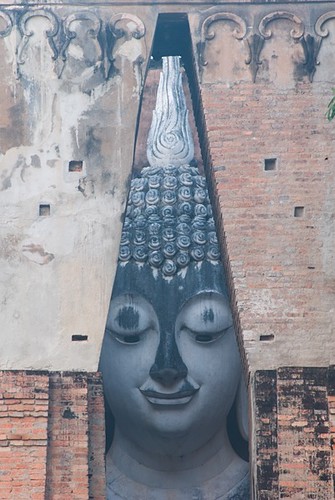

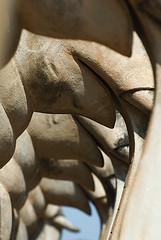



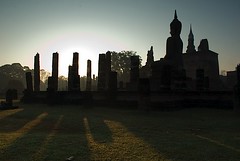
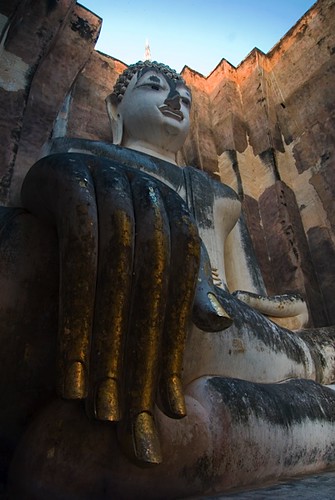





They are really very very beautiful photographs Bill
ReplyDeletethankyou for sharing them. I do love the accompanying
text and the feeling of pre-dawn they conjure - very
inspiring
Trudy
informative and nicely written blog...love the pics thanks for sharing
ReplyDelete